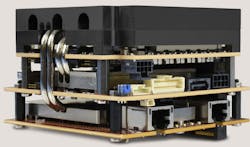Check out our AUVSI Xponential 2023 coverage.
What you’ll learn:
- What is a PCIe/104 stack-down?
- Why 10G Ethernet is important in embedded systems.
PCIe/104 is a compact, stackable architecture designed to handle high-speed, high-performance single-board computers (SBCs) and peripherals. The boards utilize one to three banks of sockets to connect one board to another in the stack. The interface incorporates PCI Express (PCIe), which is a point-to-point, high-speed serial interface; the three-bank version supports a x16 PCIe interface. The peripheral stacks can be built up or down from the host.
VersaLogic’s EPM-E9 10G Ethernet expansion module is a PCIe/104 Type 1 board that provides a pair of 10G interfaces (see figure). It’s a stack-down adapter that’s designed to go under the SBC. A typical configuration from VersaLogic places the EPM-E9 under the six-core, Xeon-E-based EPMe-51 Sabertooth SBC.
The Ethernet adapter utilizes x8 PCIe lanes and passes the remaining eight lanes to any boards underneath it. This would allow a pair of EPM-E9 10G boards to be included in a PCIe/104 stack, which would use up all of the PCIe lanes. Many peripheral boards require fewer PCIe lanes. The number of boards needed usually depends on the bandwidth required by the peripherals. This is low for interfaces like RS-232 serial ports or relay interfaces.
The 10G interfaces, which can handle 1G, 2.5G, 5G, and 10GBASE-T connections, support the IEEE 1588/802.1AS Precision Time Protocol. They also support the IEEE 802.3-az energy-efficiency standard and the PXE network boot standard. Drivers are available for Windows and Linux.
Links
- VersaLogic
- EPM-E9 10G expansion module (spec sheet)
- EPMe-51 Sabertooth single board computer (spec sheet)


